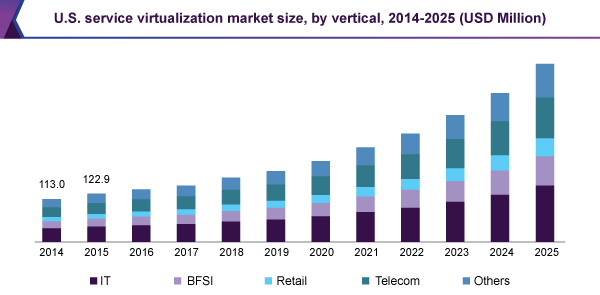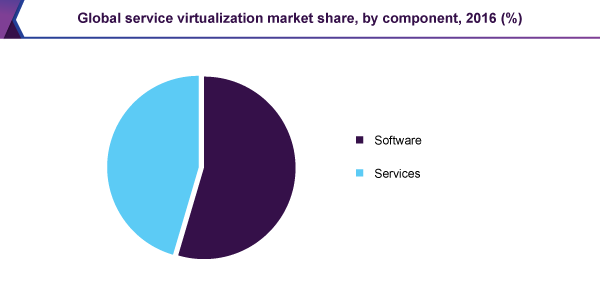- Home
- »
- Next Generation Technologies
- »
-
Service Virtualization Market Size & Share Report, 2018-2025GVR Report cover
![Service Virtualization Market Size, Share & Trends Report]()
Service Virtualization Market Size, Share & Trends Analysis Report By Component (Software, Services), By Deployment Type (On-premises, Cloud), By Vertical (IT, BFSI, Retail, Telecom), And Segment Forecasts, 2018 - 2025
- Report ID: GVR-2-68038-364-5
- Number of Report Pages: 84
- Format: PDF, Horizon Databook
- Historical Range: 2014 - 2015
- Forecast Period: 2017 - 2025
- Industry: Technology
Report Overview
The global service virtualization market size was valued at USD 410.8 million in 2016. It is expected to exhibit a CAGR of 17.6% over the forecast period. Service virtualization can be defined as a set of tools and services designed for the abstraction of a physical service through a proxy or intermediary service. It helps businesses to attain higher efficiency, increased development productivity, reduced time to market, streamlined workflows, and improved collaboration between testing and development teams.

The U.S. is anticipated to witness significant growth over the forecast period, owing to the growing demand for IoT, cloud computing, and mobility solutions & services in the commercial and industrial sectors. An increasing number of mobile users across the country along with higher adoption of advanced digital technologies are stirring up the demand for innovative solutions and services, which in turn is stoking market growth.
Factors such as enhanced quality of test conditions and accelerated time to market are estimated to propel the market. Increasing investments made by enterprises in information technologies such as connected devices and cloud are projected to accelerate the growth of the market during the forecast period.
Solutions can be integrated into numerous combinations to cater to various business needs and automate the processes of software development. Companies such as CA Technologies, IBM Corporation, Micro Focus, Smartbear Software, and Parasoft are focusing on research and development activities to develop new and innovative products, solutions, and services for various industries.
Component Insights
On the basis of components, the market has been segmented into software and services. The software segment was at the forefront of the market in 2016. Software or tools offered by market players focus upon catering to different needs of an organization.

On the basis of service, the market is broadly divided into managed and professional services. Managed services include support and tracking & monitoring services; whereas professional ones consist of consulting, design & development, and implementation. The services segment is poised to register the highest CAGR over the forecast period.
These solutions offer cost benefits and ensure high operational efficiencies. Application development teams can leverage service virtualization to create virtual testing services easily.
Deployment Type Insights
Based on deployment, the market can be divided into on-premises and cloud. The cloud segment represented the leading share in the market in 2016. Technological proliferation has led to increased adoption of cloud technology as it caters to various business needs.
Benefits such as scalability, cost-efficiency, and flexibility offered by the cloud-based platforms are prompting users to switch from the existing on-premises to cloud deployment type. Owing to this, the segment will continue to maintain its lead until 2025, expanding at the highest CAGR.
Vertical Insights
The IT segment is expected to command the largest revenue share in the service virtualization market throughout the forecast period. Service virtualization tools address several issues related to difficulties faced by the IT industry including software quality, application downtime, and release timelines. It delivers solutions and services that improve business competence and help in meeting customer needs.
The BFSI segment is anticipated to rise at the highest CAGR over the forecast period due to the surging adoption of software solutions and tools in banking operations. The growth of the segment is mainly driven by the increasing penetration of smartphones, gadgets, and connected devices in banking operations.
Regional Insights
The North America region was the leading revenue contributor in 2016. Technological proliferation, improved network connectivity, and burgeoning trend of digitalization are some of the key factors contributing to the growth of the region. Domicile of several technology giants is helping the regional market maintain a competitive edge over other regions.
However, Asia Pacific is estimated to register the highest CAGR over the forecast period, owing to spiraling demand for digital services and growing investments by governments in connected devices and networking & communication technologies. Additionally, the European market is projected to witness a significant growth rate over the forecast period owing to rising digitalization and the emergence of connected devices technology.
Service Virtualization Market Share Insights
The market has a presence of various major players such as CA Technologies, IBM Corporation, Micro Focus, Smartbear Software, Parasoft, Sogeti (Capgemini), Maveric Systems, and Prolifics.
A majority of key players in the market are concentrating on growth strategies such as establishing strategic collaborations and partnerships with smaller players to increase the share in the market. In an attempt to gain competitive advantage, prominent players are increasing their spending on research and development activities and investing in innovation and technologically advanced labs and research centers.
Service Virtualization Market Report Scope
Report Attribute
Details
Market size value in 2020
USD 698.3 million
Revenue forecast in 2025
USD 1694.9 million
Growth rate
CAGR of 18.8% from 2018 to 2025
Base year for estimation
2017
Historical data
2014 - 2015
Forecast period
2018 - 2025
Quantitative Units
Revenue in USD million and CAGR from 2018 to 2025
Report coverage
Revenue forecast; company share; competitive landscape; growth factors; and trends
Segments covered
Component; deployment type; vertical; region
Regional scope
North America; Europe; Asia Pacific; RoW
Country scope
U.S.; Canada; U.K.; Germany; China; India; and Japan
Key companies profiled
CA Technologies; IBM Corporation; Micro Focus; Smartbear Software; Parasoft; Sogeti (Capgemini); Maveric Systems; and Prolifics.
Customization scope
Free report customization (equivalent up to 8 analyst’s working days) with purchase. Addition or alteration to country; regional & segment scope.
Pricing and purchase options
Avail customized purchase options to meet your exact research needs. Explore purchase options
Segments Covered in the ReportThis report forecasts revenue growth at global, regional, and country levels and provides an analysis of industry trends in each of the sub-segments from 2014 to 2025. For this study, Grand View Research has segmented the global service virtualization market report based on component, deployment type, vertical, and regions:
-
Component Outlook (Revenue, USD Million, 2014 - 2025)
-
Software
-
Services
-
-
Deployment Type Outlook (Revenue, USD Million, 2014 - 2025)
-
On-premise
-
Cloud
-
-
Vertical Outlook (Revenue, USD Million, 2014 - 2025)
-
IT
-
BFSI
-
Retail
-
Telecom
-
Others
-
-
Regional Outlook (Revenue, USD Million, 2014 - 2025)
-
North America
-
The U.S.
-
Canada
-
-
Europe
-
Germany
-
U.K.
-
-
Asia Pacific
-
China
-
India
-
Japan
-
-
RoW
-
Share this report with your colleague or friend.
![gvr icn]()
NEED A CUSTOM REPORT?
We can customize every report - free of charge - including purchasing stand-alone sections or country-level reports, as well as offer affordable discounts for start-ups & universities. Contact us now
![Certified Icon]()
We are GDPR and CCPA compliant! Your transaction & personal information is safe and secure. For more details, please read our privacy policy.
We are committed towards customer satisfaction, and quality service.
"The quality of research they have done for us has been excellent."





